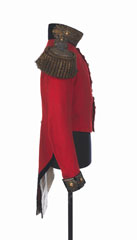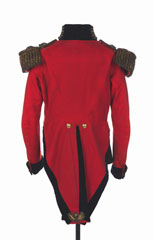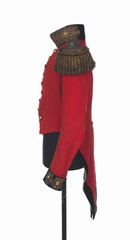
Online Collection
« Prev - 1 of 1 results - Next »
Coatee, worn by General Sir Charles William Vane, 3rd Marquess of Londonderry, Colonel of 2nd Regiment of Life Guards, 1848 (c)
Scarlet wool cloth with blue velvet facings, with gold metal thread embroidery at collar and cuffs, and gilt buttons by Jennens and Company, London.
Charles William Stewart (1778-1854) was of Anglo-Irish descent and was educated at Eton. He was commissioned into the British Army and saw active service in Flanders during the French Revolutionary Wars (1792-1802) and in Ireland during the Irish Rebellion of 1798. Stewart rose to the rank of lieutenant colonel, serving with the 5th (or Royal Irish) Regiment of Dragoons and the 18th Light Dragoons.
In 1800, Stewart began a political career and from 1807 to 1809 he was Under-Secretary of State for War and the Colonies under his half-brother, Robert Stewart, Viscount Castlereagh. Stewart returned to military campaigning in 1808, serving under Sir John Moore and the future Duke of Wellington, Sir Arthur Wellesley, during the Peninsular War (1808-1814). Thought of as brave but reckless, he did not progress in the Army and so embarked on a diplomatic career, serving in Austria and Prussia, where his reputation for womanising was enhanced. Stewart became a Knight Companion of the Bath in 1813 and he was raised to the peerage as Baron Stewart in 1814.
Stewart's first wife died after just eight years of marriage and he remarried in 1819. His new partner, Lady Frances Anne Emily Vane-Tempest (1800-1865), brought with her significant land and wealth, and Stewart adopted her name. In 1822, after Castlereagh committed suicide, Sir Charles Vane succeeded to the title of 3rd Marquess of Londonderry.
Vane was Colonel of the 10th (The Prince of Wales's Own) Royal Regiment of Light Dragoons (Hussars) from 1820 to 1843. Vane eventually rose to the rank of general and became Colonel of the 2nd Regiment of Life Guards in 1843. Having served with him in the Peninsula, Vane was a pall bearer at the Duke of Wellington's funeral in 1852, and he replaced him as a Knight of the Garter in 1853. He died of influenza on 6 March 1854.
NAM Accession Number
NAM. 1963-10-346-1
Copyright/Ownership
National Army Museum Copyright
Location
National Army Museum, Study collection
Object URL
https://collection.nam.ac.uk/detail.php?acc=1963-10-346-1




